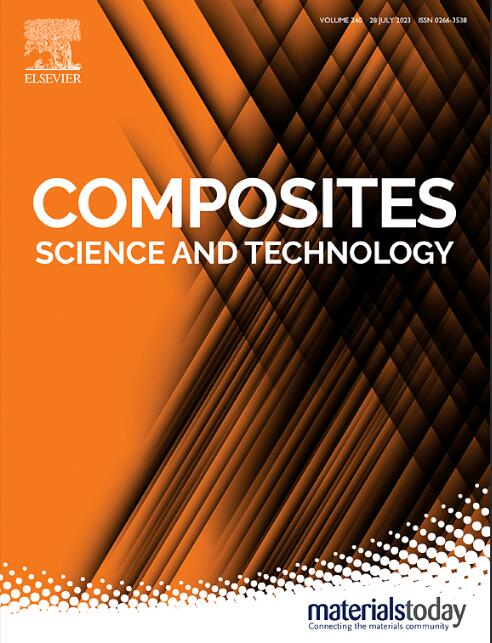由并行工程石墨烯集成制备的具有三维各向异性导热和导电性的树启发生物复合材料
IF 8.3
1区 材料科学
Q1 MATERIALS SCIENCE, COMPOSITES
引用次数: 0
摘要
在自然界中,许多生物材料由于其独特的微观结构特征而表现出各向异性的物理和化学特性。受此启发,人工复合材料可以精心设计以复制这种各向异性行为并获得目标性能。在这里,我们以去木素化木材为模板,通过静电自组装和致密化的协同过程,成功构建了具有平行排列石墨烯结构的木材/石墨烯生物复合材料。通过设计平行排列的石墨烯结构,实现了声子和电子传输路径的调制,并在不同方向上表现出不同的传播特性。这种结构安排使生物复合材料具有独特的三维正交各向异性导热性能和导电性能。具体来说,含有0.5 wt%石墨烯的生物复合材料在x、y和z方向上的导热系数分别为0.77、0.25和0.12 W/m·K−1,比天然木材显著提高2.1-11.8倍。同时,不同方向的电导率从10−12 S/cm显著提高到10−4-100 S/cm。此外,生物复合材料显示出优异的抗拉强度,达到79.1 MPa,并具有显著的阻燃性能。总之,这项研究为制备具有三维正交各向异性热电性能的复合材料提供了一种开创性的策略,这种功能使它们能够用于热管理应用,如隔热和散热。本文章由计算机程序翻译,如有差异,请以英文原文为准。

Tree-inspired bio-composites with 3D anisotropic thermal and electrical conductivities prepared by parallel-engineered graphene integration
In nature, numerous bio-materials exhibit anisotropic physical and chemical properties, attributable to their distinctive microstructural characteristics. Inspired by this, artificial composites can be meticulously designed to replicate such anisotropic behavior and attain targeted properties. Here, we successfully constructed wood/graphene bio-composites with parallel-aligned graphene structures by a synergistic process of electrostatic self-assembly and densification using delignified wood as a template. Through the design of parallel-arranged graphene structures, the modulation of phonon and electron transport paths is achieved and differentiated propagation properties are exhibited along different directions. This structural arrangement endows the bio-composites with unique 3D orthogonal anisotropic thermal and electrical conductivity properties. Specifically, the bio-composites integrated with 0.5 wt% graphene demonstrated thermal conductivity of 0.77, 0.25, and 0.12 W/m·K−1 in the x, y, and z directions, respectively, representing a significant enhancement of 2.1–11.8 times over that of natural wood. Concurrently, the electrical conductivity in different directions was markedly improved from 10−12 to 10−4-100 S/cm. Furthermore, the bio-composites showcased superior tensile strength, reaching up to 79.1 MPa, along with notable flame-retardant properties. In Summary, this research provides a pioneering strategy for the preparation of composites with 3D orthogonal anisotropic thermal and electrical properties, a functionality that enables them to be used for thermal management applications such as thermal insulation and heat dissipation.
求助全文
通过发布文献求助,成功后即可免费获取论文全文。
去求助
来源期刊

Composites Science and Technology
工程技术-材料科学:复合
CiteScore
16.20
自引率
9.90%
发文量
611
审稿时长
33 days
期刊介绍:
Composites Science and Technology publishes refereed original articles on the fundamental and applied science of engineering composites. The focus of this journal is on polymeric matrix composites with reinforcements/fillers ranging from nano- to macro-scale. CSTE encourages manuscripts reporting unique, innovative contributions to the physics, chemistry, materials science and applied mechanics aspects of advanced composites.
Besides traditional fiber reinforced composites, novel composites with significant potential for engineering applications are encouraged.
 求助内容:
求助内容: 应助结果提醒方式:
应助结果提醒方式:


